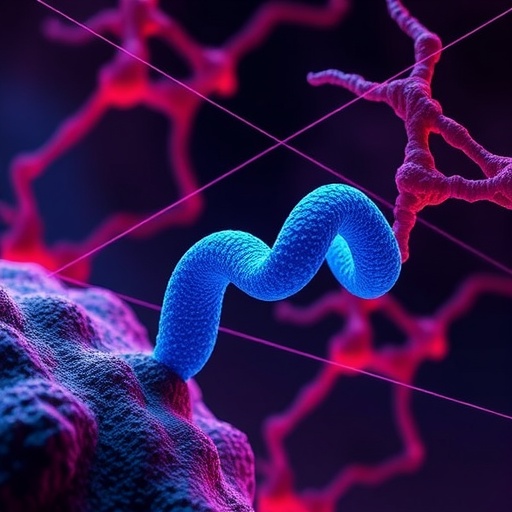In the relentless quest to unravel cancer’s secrets and develop more effective therapies, mitochondria have emerged as critical players. New research led by Bohacova, Nahacka, Dudova, and colleagues brings the mitochondrial protein ANT2 into the spotlight, revealing its multifaceted role in cancer cell survival and mitochondrial function. Their findings, published in Cell Death Discovery, open fresh avenues for therapeutic intervention targeting this often-overlooked component of cellular energetics.
Mitochondria, colloquially termed the powerhouses of the cell, are essential for producing adenosine triphosphate (ATP), the energy currency vital for cellular processes. However, their role extends well beyond energy production—they regulate apoptosis (programmed cell death), calcium homeostasis, and reactive oxygen species (ROS) generation. Within this complex biochemical orchestra, the adenine nucleotide translocase (ANT) family facilitates ATP/ADP exchange across the mitochondrial inner membrane, thus balancing energy supply and demand.
ANT2, one of the isoforms within this family, distinguishes itself through its expression pattern and functional implications. Unlike its counterpart ANT1, which is predominantly present in differentiated tissues, ANT2 is mainly expressed in proliferative and undifferentiated cells, including cancer cells. This differential expression pattern suggests that ANT2 could be intricately linked to the unique metabolic demands and survival strategies of malignant cells.
The study meticulously delineates how ANT2 supports cancer cell survival by maintaining mitochondrial function under the stressful microenvironment that tumors frequently experience. This microenvironment is characterized by hypoxia, nutrient scarcity, and elevated oxidative stress, challenges that cancer cells must adeptly navigate. By facilitating the ADP/ATP exchange tailored to the altered metabolic state, ANT2 helps sustain bioenergetic competence, allowing cancer cells to thrive even under adverse conditions.
Crucially, the researchers employed a combination of molecular biology techniques, including gene silencing and overexpression models, to interrogate ANT2’s role. Knocking down ANT2 expression consistently resulted in disrupted mitochondrial membrane potential, elevated ROS levels, and the initiation of apoptotic cascades. These findings highlight ANT2’s protective function in cancer cell mitochondria, preventing energy collapse and oxidative damage-induced cell death.
Further biochemical analyses revealed that ANT2 modulates mitochondrial permeability transition pores (mPTP), critical regulators of apoptosis. By influencing mPTP opening thresholds, ANT2 helps cancer cells evade apoptosis, a hallmark of cancer progression and resistance to chemotherapy. This modulation appears to be finely tuned, balancing survival signals against the risk of catastrophic mitochondrial dysfunction.
The researchers also uncovered intriguing links between ANT2 activity and metabolic reprogramming in cancer cells—a phenomenon famously described as the Warburg effect. ANT2’s facilitation of ATP export supports glycolytic flux and mitochondrial oxidative phosphorylation, maintaining a dynamic balance advantageous for rapid proliferation. This dual capacity endows cancer cells with metabolic flexibility, enabling adaptation to fluctuating nutrient and oxygen availability.
Importantly, targeting ANT2 disrupted these metabolic adaptations, sensitize cancer cells to chemotherapeutic agents, and restrained tumor growth in preclinical models. The suppression of ANT2 expression increased susceptibility to apoptosis-inducing drugs and impaired mitochondrial bioenergetics, uncovering a promising therapeutic vulnerability. This positions ANT2 not just as a biomarker but as a high-value target for drug development efforts.
The study’s implications extend beyond a single protein. By situating ANT2 within the broader context of mitochondrial dynamics, it underscores the mitochondrion’s emerging role as a hub for cancer cell survival signaling. While traditional therapies often focus on nuclear or cytoplasmic targets, modulating mitochondrial components such as ANT2 could usher in precision interventions with improved efficacy and reduced resistance.
In light of INNOVATIVE mitochondrial oncology strategies, pharmaceutical efforts can now consider ANT2 inhibitors as candidates for combination therapies. These inhibitors would ideally disrupt cancer cell bioenergetics without compromising normal tissue function, given ANT2’s limited expression in non-proliferative cells. The feasibility of such selective targeting could revolutionize the therapeutic landscape.
Moreover, ANT2’s involvement in regulating mitochondrial permeability and redox homeostasis offers a dual-axis approach to anticancer strategies. Therapies that simultaneously induce oxidative stress and inhibit ANT2-mediated protection could overwhelm the malignant cells’ defenses, tipping the balance toward apoptosis. This integrated approach could counteract the notorious adaptability of tumors.
Given the complexity of cancer metabolism, it is noteworthy that ANT2’s role extends into signaling networks intertwining energy balance with cellular survival pathways. Mitochondria-nuclear crosstalk mediated by ANT2 may influence gene expression programs governing proliferation and resistance phenotypes—an exciting frontier for future research. Exploring this genomic-mitochondrial dialogue could uncover additional therapeutic nodes.
Despite these promising insights, translation from bench to bedside requires caution. ANT2’s functions in normal stem and progenitor cells necessitate rigorous assessment to avoid unintended toxicities. Advanced delivery mechanisms and highly selective inhibitors will be pivotal in leveraging ANT2-targeted therapies safely in clinical contexts.
The work by Bohacova and colleagues reflects a growing appreciation for the subtleties of mitochondrial biology in oncology. By identifying ANT2 as a linchpin for mitochondrial integrity and cancer cell viability, this research paves the way for exploiting mitochondrial vulnerabilities in cancer. Subsequent studies on ANT2 regulation, interaction partners, and structure-function relationships will be critical next steps.
In conclusion, the ANT2 protein emerges as a compelling therapeutic target whose inhibition could disrupt mitochondrial bioenergetics and confer heightened sensitivity to cancer treatments. This discovery not only deepens our understanding of mitochondrial involvement in tumor survival but also invigorates the field of mitochondrial oncology with translational potential. As cancer research continues to integrate cellular metabolism and survival paradigms, ANT2 stands out as a beacon of hope and a testament to the intricate biology underlying malignancy.
Subject of Research: Role of ANT2 in mitochondrial function and cancer cell survival as a target for therapeutic intervention.
Article Title: Role of ANT2 in mitochondrial function and cancer cell survival: a target for therapeutic intervention.
Article References:
Bohacova, K., Nahacka, Z., Dudova, J. et al. Role of ANT2 in mitochondrial function and cancer cell survival: a target for therapeutic intervention. Cell Death Discov. 11, 225 (2025). https://doi.org/10.1038/s41420-025-02510-z
Image Credits: AI Generated




